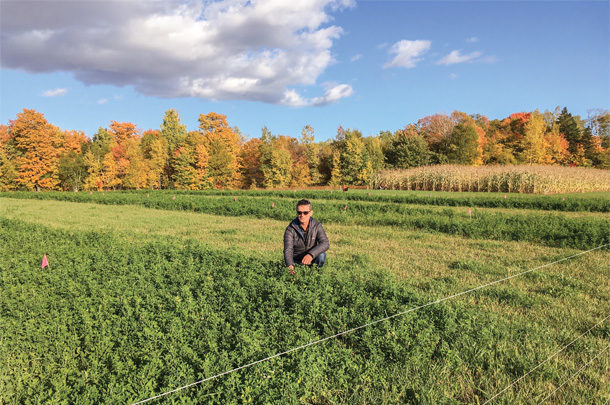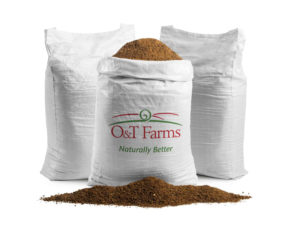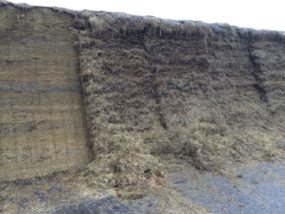A research project was carried out to determine interest in using more digestible alfalfa under local agroclimate conditions to obtain an objective opinion on the performance of these alfalfa varieties in Quebec.
A recent study conducted by Marie-Soleil Boucher and her collaborators concluded that among the eight cultivars studied, only the genetically modified alfalfa cultivars had a higher neutral detergent fibre (NDF) digestibility than the controls. These cultivars can therefore be used in two ways on the farm. They can be:
1. Harvested at the usual stage to increase NDF digestibility
2. Harvested later to increase yield without negatively affecting NDF digestibility
Given the high price of genetically modified seeds, many wonder if it is profitable for the average dairy farm to use this type of alfalfa.
Profitable in certain situations
To answer this question, we conducted a technoeconomic analysis using data from 2016 to 2018 from Agritel. Looking at Quebec dairies, the typical farm had 71 hectares (175 acres) in grassland with 99 cows fed a ration containing corn silage, producing 9,821 kilograms of milk per cow per year. The alfalfa was not fed directly to the cows. We used reference values showing that each unit increase in NDF digestibility was associated with a 0.17-kilogram- per-day increase in feed intake and a 0.23-kilogram-per-day increase in milk production. These effects were observed up to 177 days in milk (DIM). Therefore, we considered the improvement of dairy performance of cows fed a genetically modified alfalfa-based ration from early to mid-lactation.
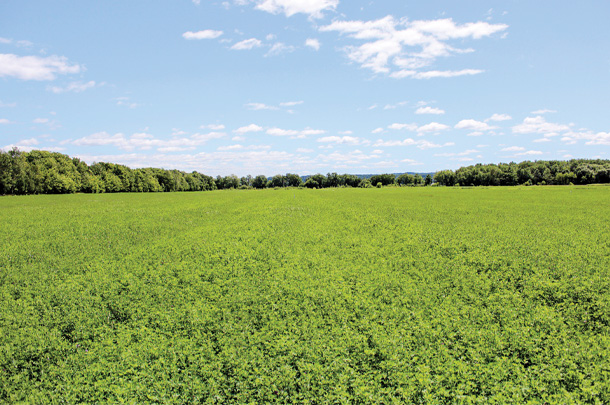 Photo by Jean-Philippe Laroche.
Photo by Jean-Philippe Laroche.Scenario 1: Harvest at early flowering stage
In the first scenario tested, the genetically modified alfalfa and the control alfalfa were harvested at the same stage of development. The genetically modified alfalfa was more digestible in this case. Here, we present only the results for harvesting at the early flowering stage (less than 10% in bloom), since the effect on net profit would be most interesting for dairy farmers with this cutting management. To manage the increase in cow productivity caused by the ingestion of more digestible alfalfa, producers have two choices: either buy quota or sell animals and keep their current quota. Since this choice has an impact on the net profit of the business, we performed the analysis for both situations.
Under the quota purchase scenario, genetically modified alfalfa would increase revenues associated with milk sales (see Scenario 1 in Table 1).
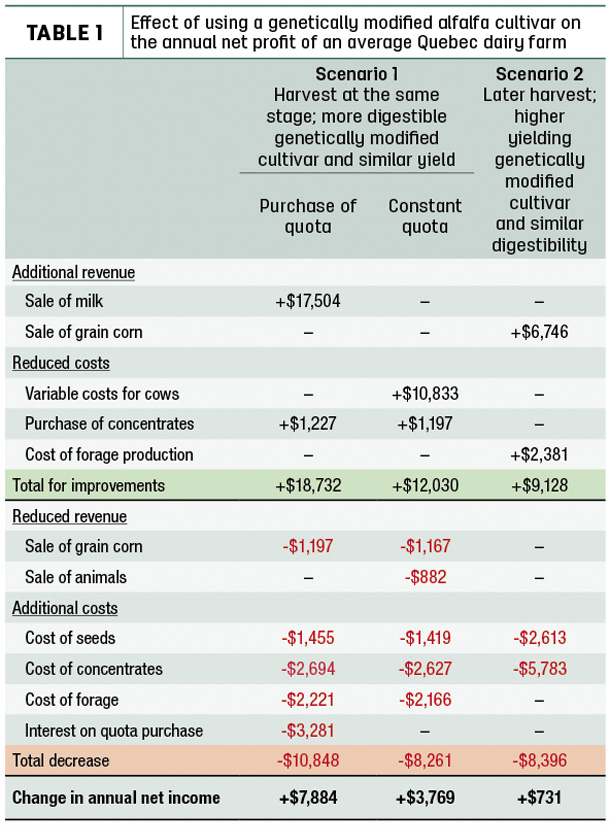
In addition, the higher energy content of genetically modified alfalfa caused by its higher digestibility would reduce the amount of feed concentrates in the rations. However, the increased feed intake by the cows would require more forage. Some grain corn acreage would have to be sacrificed to increase the amount of alfalfa produced. The higher feed intake would also increase feed costs (cost of concentrates and forage). Finally, the additional cost of genetically modified alfalfa seed, as well as the interest cost associated with the purchase of quota, should also be considered. The result is an increase in annual net profit by $7,884 per year for the farm, or $80 per cow per year, that would be associated with the use of genetically modified alfalfa.
If the producer decided to sell cows instead of purchasing quota, the additional sale of milk and the interest cost of purchasing quota would be replaced by a decrease in variable costs associated with the cows and a decrease in revenue from the sale of animals (see “Constant quota,” Table 1). This would result in an increase in annual net profit of $3,769 per year for the farm, or $38 per cow per year, associated with the use of genetically modified alfalfa.
Scenario 2: Late harvest
In the second scenario, the genetically modified alfalfa harvest is delayed, allowing for higher yields while maintaining NDF digestibility similar to the control alfalfa harvested earlier (see Scenario 2, Table 1). The additional yield would allow the farm to free up acreage and grow more grain corn, which would increase income. In addition, it would lower the cost of forage production. However, the higher cost of genetically modified alfalfa seed has to be considered. Also, the cost of feed concentrates in the ration would be greatly increased.
Although NDF digestibility is similar for both types of alfalfa, crude protein (CP) content is reduced when genetically modified alfalfa is harvested at a later stage. This results in a higher protein supplementation requirement for the cows. Here, there is no need to purchase quota or change the number of cows, since no change in milk production would be expected.
In the end, the increase in annual net profit associated with the use of a genetically modified alfalfa cultivar would be lower in this scenario, at $731 per year for the farm, or $7 per cow per year. However, this scenario has the advantage of giving the producer more flexibility in timing the harvest (on average seven days).
Sensitivity analysis of these two scenarios indicates that the results remain robust when the improvement in cultivar digestibility, the cost of concentrates, the cost of seed or the margin on variable costs of growing grain corn are increased or decreased by 10%.
Conclusions
Based on our modeling results, genetically modified alfalfa cultivars could be economically interesting when used to increase NDF digestibility. The additional net benefit would be more significant when the increase in cow productivity is associated with a quota purchase. However, it would also be important to repeat the experiment by including this alfalfa in a ration provided to cows to measure the performance under actual barn circumstances.
The elements presented in this article provide a better understanding of the use of genetically modified alfalfa cultivars on the farm. If producers choose to use these cultivars, they will need to ensure the risks associated with this technology are minimized to respect producers with a different point of view. To do so, producers must consult and follow the “Coexistence Plan for Alfalfa Hay in Eastern Canada.” This document, available free of charge online, outlines the best practices to reduce the risks of contamination between genetically modified and standard cultivars.
This study was made possible thanks to the financial support of the Quebec consortium for industrial bioprocess research and innovation, in partnership with Novalait and the Natural Sciences and Engineering Research Council of Canada.
CULTIVARS OF CONCERN
There is controversy surrounding the use of genetically modified alfalfa cultivars. First, it should be noted that Les producteurs de lait du Québec and the Union des producteurs agricoles opposed the introduction of this technology in the province. The reason for this opposition is mainly the risk of gene transfer through cross-pollination between genetically modified cultivars and standard cultivars. There is also a risk of physical contamination of the seeds and a risk of hard seeds germinating after several years. These risks are of concern to many in the industry, including organic milk producers who are not allowed to use genetically modified plants. This is also a concern for the seed industry since the European Union does not tolerate genetically modified seeds. Finally, the honey industry is concerned about potential contamination by pollen from genetically modified plants.
The other aspect that is being written about extensively is the glyphosate resistance gene also found in these genetically modified cultivars. This gene could promote the use of glyphosate, which is already often used in crop rotations. The repeated use of the same groups of herbicides could then contribute to the appearance of resistant weeds, a growing problem. The glyphosate resistance gene could also promote the establishment of pure alfalfa grasslands since other perennial forages do not have this resistance gene. However, the use of forage mixtures has significant benefits, such as yield, weed control, winter survival, nitrogen cycling and nutrient value. Of course, users of this technology do not have to plant a pure crop and spray with glyphosate when planting genetically modified alfalfa.

